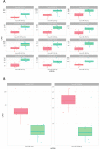MicroRNA expression analysis in peripheral blood and soft-tissue of patients with periprosthetic hip infection
- PMID: 38839054
- PMCID: PMC11152758
- DOI: 10.1302/2633-1462.56.BJO-2023-0172.R2
MicroRNA expression analysis in peripheral blood and soft-tissue of patients with periprosthetic hip infection
Abstract
Aims: Current diagnostic tools are not always able to effectively identify periprosthetic joint infections (PJIs). Recent studies suggest that circulating microRNAs (miRNAs) undergo changes under pathological conditions such as infection. The aim of this study was to analyze miRNA expression in hip arthroplasty PJI patients.
Methods: This was a prospective pilot study, including 24 patients divided into three groups, with eight patients each undergoing revision of their hip arthroplasty due to aseptic reasons, and low- and high-grade PJI, respectively. The number of intraoperative samples and the incidence of positive cultures were recorded for each patient. Additionally, venous blood samples and periarticular tissue samples were collected from each patient to determine miRNA expressions between the groups. MiRNA screening was performed by small RNA-sequencing using the miRNA next generation sequencing (NGS) discovery (miND) pipeline.
Results: Overall, several miRNAs in plasma and tissue were identified to be progressively deregulated according to ongoing PJI. When comparing the plasma samples, patients with a high-grade infection showed significantly higher expression levels for hsa-miR-21-3p, hsa-miR-1290, and hsa-miR-4488, and lower expression levels for hsa-miR-130a-3p and hsa-miR-451a compared to the aseptic group. Furthermore, the high-grade group showed a significantly higher regulated expression level of hsa-miR-1260a and lower expression levels for hsa-miR-26a-5p, hsa-miR-26b-5p, hsa-miR-148b-5p, hsa-miR-301a-3p, hsa-miR-451a, and hsa-miR-454-3p compared to the low-grade group. No significant differences were found between the low-grade and aseptic groups. When comparing the tissue samples, the high-grade group showed significantly higher expression levels for 23 different miRNAs and lower expression levels for hsa-miR-2110 and hsa-miR-3200-3p compared to the aseptic group. No significant differences were found in miRNA expression between the high- and low-grade groups, as well as between the low-grade and aseptic groups.
Conclusion: With this prospective pilot study, we were able to identify a circulating miRNA signature correlating with high-grade PJI compared to aseptic patients undergoing hip arthroplasty revision. Our data contribute to establishing miRNA signatures as potential novel diagnostic and prognostic biomarkers for PJI.
© 2024 Paksoy et al.
Conflict of interest statement
The authors have no conflicts of interest to disclose. D. Akgün reports that this study was supported by the Stiftung Endoprothetik.
Figures




Similar articles
-
Atrophic gastritis and gastric cancer tissue miRNome analysis reveals hsa-miR-129-1 and hsa-miR-196a as potential early diagnostic biomarkers.World J Gastroenterol. 2022 Feb 14;28(6):653-663. doi: 10.3748/wjg.v28.i6.653. World J Gastroenterol. 2022. PMID: 35317427 Free PMC article.
-
Identification of plasma miR-4505, miR-4743-5p and miR-4750-3p as novel diagnostic biomarkers for coronary artery disease in patients with type 2 diabetes mellitus: a case-control study.Cardiovasc Diabetol. 2024 Jul 29;23(1):278. doi: 10.1186/s12933-024-02374-0. Cardiovasc Diabetol. 2024. PMID: 39080630 Free PMC article.
-
Identification of non-invasive biomarkers for chronic atrophic gastritis from serum exosomal microRNAs.BMC Cancer. 2019 Feb 8;19(1):129. doi: 10.1186/s12885-019-5328-7. BMC Cancer. 2019. PMID: 30736753 Free PMC article.
-
A Panel of MicroRNA Signature as a Tool for Predicting Survival of Patients with Urothelial Carcinoma of the Bladder.Dis Markers. 2018 Jun 20;2018:5468672. doi: 10.1155/2018/5468672. eCollection 2018. Dis Markers. 2018. PMID: 30026881 Free PMC article.
-
MicroRNA profiling in women with migraine: effects of CGRP-targeting treatment.J Headache Pain. 2024 May 16;25(1):80. doi: 10.1186/s10194-024-01787-2. J Headache Pain. 2024. PMID: 38755568 Free PMC article. Clinical Trial.

